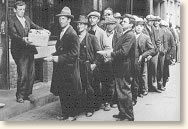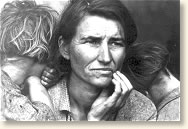The Great Depression
The Great Depression did not affect everyone the same way. Many rich people felt
no impact at all, and were oblivious to the suffering of others. Up to forty
percent of the country never faced real hardship during those
 |
Bread Line
Washington, DC, October 1930 |
years. But most
were touched by it in some way. By the time of Franklin Roosevelt's inauguration
in 1933, the unemployment rate hovered close to twenty-five percent. Fluctuating
during the 1930s, it never fell below 14.3% until 1941.
The Depression changed the family in dramatic ways. Many couples delayed marriage
- the divorce rate dropped sharply (it was too expensive to pay the legal fees
and support two households); and birth rates dropped below the replacement
level for the first time in American history. Families suffered a dramatic
loss of income during Herbert Hoover's term in office, dropping 35% in those
four years to $15M. This put a great deal of stress on families. Some reacted
by pulling together, making due with what they had, and turning to family and
friends for help. Only after exhausting all alternatives would they reluctantly
look to the government for help. Other families did not fare as well, and ended
up failing apart.
Traditional roles within the family changed during the 1930s. Men finding themselves out of work now had to rely on their wives and children in some cases to help make ends meet. Many did not take this loss of power as the primary decision maker and breadwinner very well. Many stopped looking for work, paralyzed by their bleak chances and lack of self-respect. Some became so frustrated that they just walked out on their families completely. A 1940 survey revealed that 1.5 million married women had been abandoned by their husbands.
On the other hand, women found their status enhanced by their new roles. Left
with little choice, they went
 |
A mother and her daughters
photographed on the road
by Dorthea Lange |
against the historic opposition to married women
working outside the home to help support their families. Black women especially
found it easier to obtain work than their husbands, working as domestic servants,
clerks, textiles workers and other occupations. This employment increased their
status and power in the home, gaining them a new voice in domestic decisions.
Most minorities, though, benefited little from FDR's New Deal programs. Minorities, long considered the "last hired, first fired" before the depression, were the first ones hurt by the job layoffs, In order to keep the Democratic Party together and pass New Deal legislation through a Southern-dominated Congress, most of the programs targeted unemployed white males. Black males were either shut out completely or had to settle for separate and lower pay scales. A shortage of jobs in the Southwest led to the illegal deportation of 400,000 Mexican-Americans so that whites could get more jobs or government relief. Native Americans, though, received their own New Deal, bringing economic relief and some political recognition to this most beleaguered group.
References:
Allen, Frederick Lewis, Since Yesterday: The 1930's in America (1940); Leuchtenburg, William, Franklin D. Roosevelt and The New Deal (1963).
How To Cite This Article:
"America in the Great War," EyeWitness to History, www.eyewitnesstohistory.com (2000).
|






